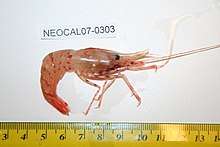Pandalus hypsinotus
Pandalus hypsinotus is a crustacean in the Pandalidae family, ordinarily 10–12.5 centimetres (3.9–4.9 in) in length, but large females may reach 17.5 centimetres (6.9 in)[2]. It can be found in the Bering Sea, from the Aleutian Islands to Puget Sound, and in the Sea of Japan at depths of 100–200 metres (330–660 ft).
| Pandalus hypsinotus | |
|---|---|
 | |
| Scientific classification | |
| Kingdom: | Animalia |
| Phylum: | Arthropoda |
| Subphylum: | Crustacea |
| Class: | Malacostraca |
| Order: | Decapoda |
| Family: | Pandalidae |
| Genus: | Pandalus |
| Species: | P. hypsinotus |
| Binomial name | |
| Pandalus hypsinotus | |
This species attains maturity as a male, and in varying proportions as a female, in the second year, and becomes a female during the third year. Subsequent survival into the fourth year is very low. Female shrimps carry eggs from November to April[2].
Called Dokdo shrimp in Japan, as they are found around the Dokdo Islands, where it is the largest of the three Dokdo shrimps. In Japan they are mainly caught in Toyama Bay, so they are called Toyama shrimp (トヤマエビ).
Called Humpback Shrimp in North America, there a small directed fishery is found in Prince Rupert[2]. where the Humpback is held to be the finest eating shrimp of all six species.
References
- Brandt, J.F. (1851). Krebse. In: von Middendorff, A.T., Reise in den äussersten Norden und Osten Sibiriens während der Jahre 1843 und 1844 mit allerhöchster Genehmigung auf Veranstaltung der Kaiserlichen Akademie der Wissenschaften zu St. Petersburg ausgeführt und in Verbinding mit vielen Gelehrten herausgegeben, 2 (Theil 1): 77-148, Plates 5-6. St. Petersburg. https://www.biodiversitylibrary.org/page/37047789
- "Shrimp and prawn biology - Pacific Region - Fisheries and Oceans Canada". Fisheries and Oceans Canada. Fisheries and Oceans Canada. Retrieved 2020-03-22.